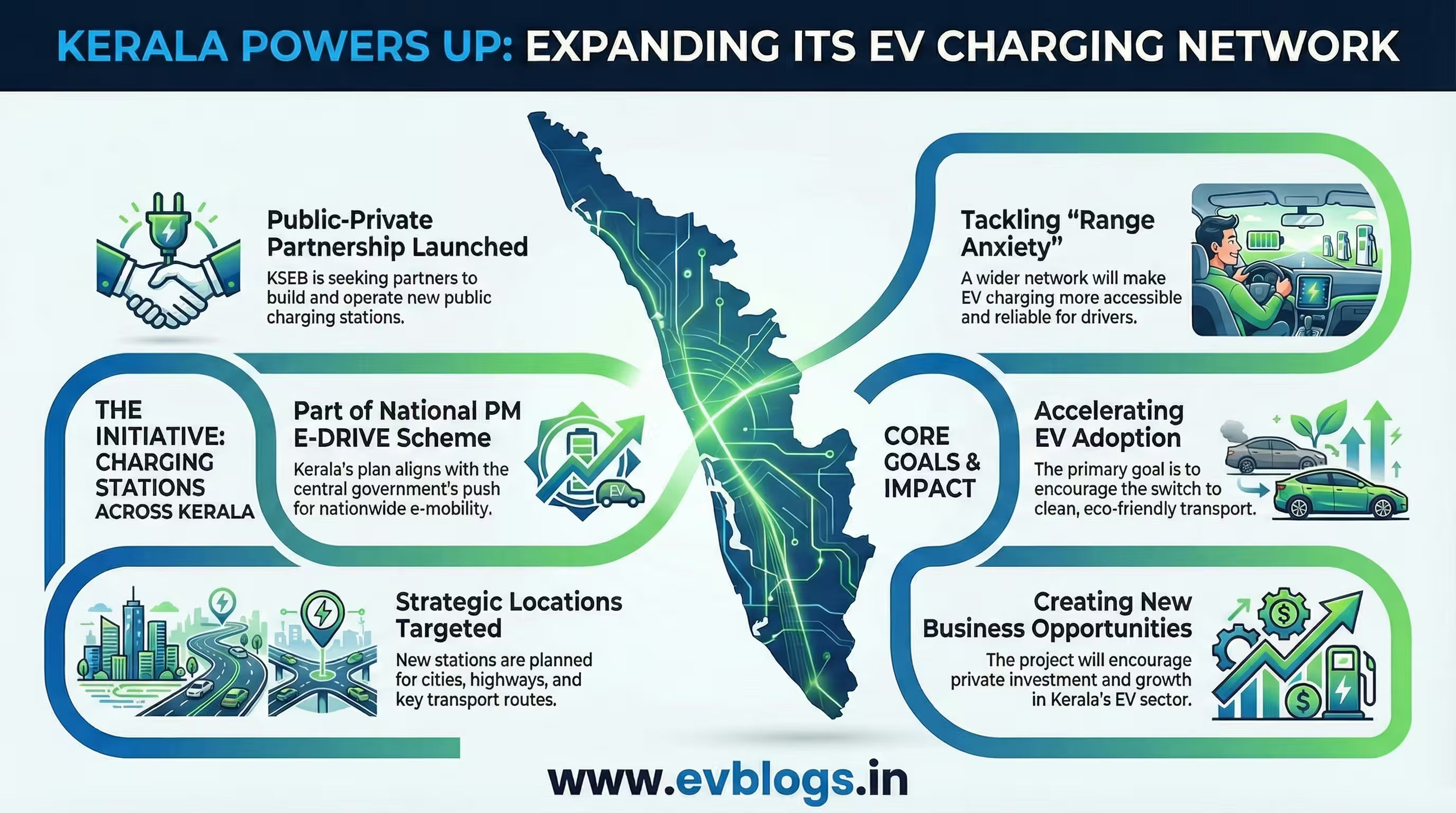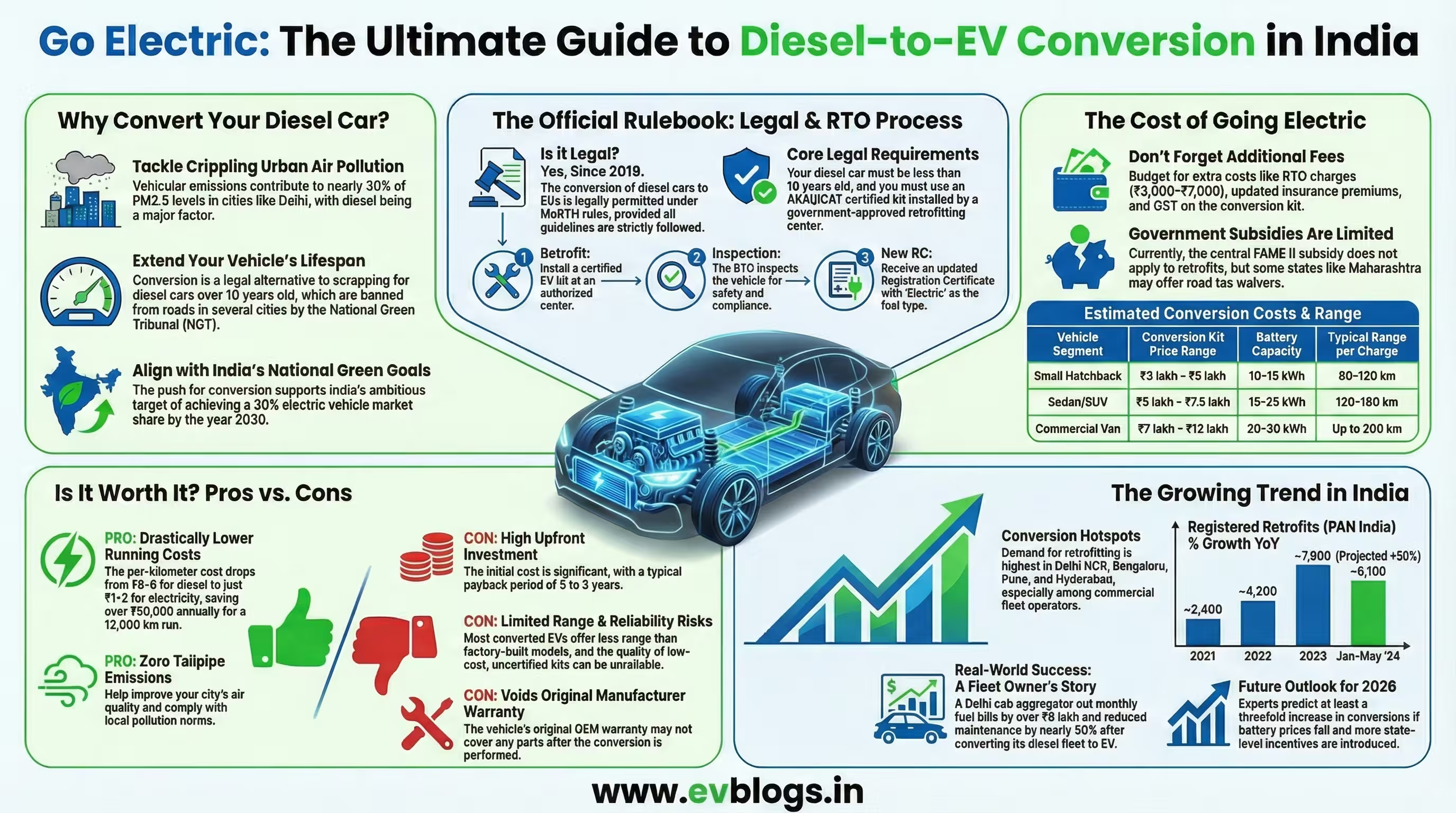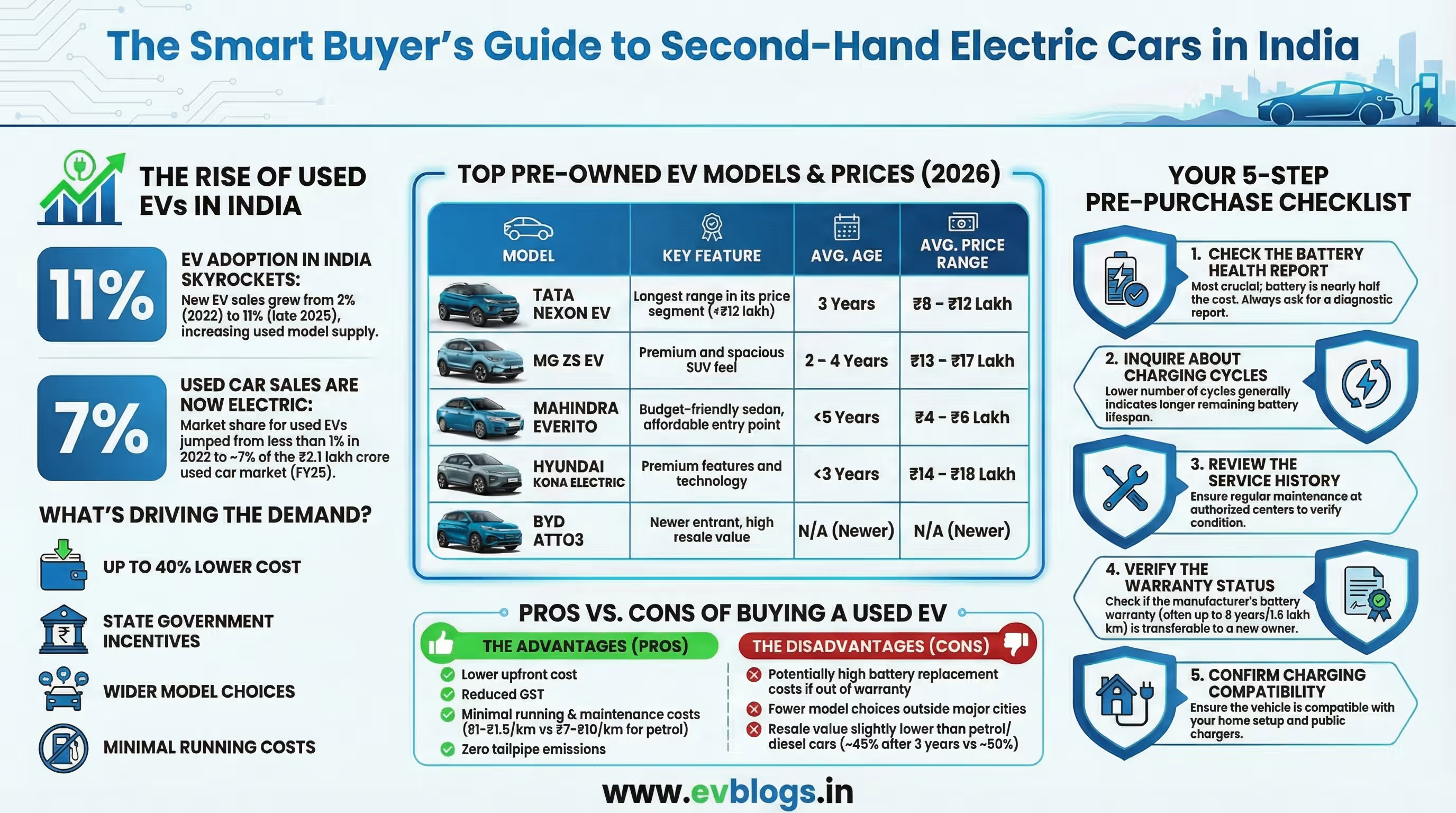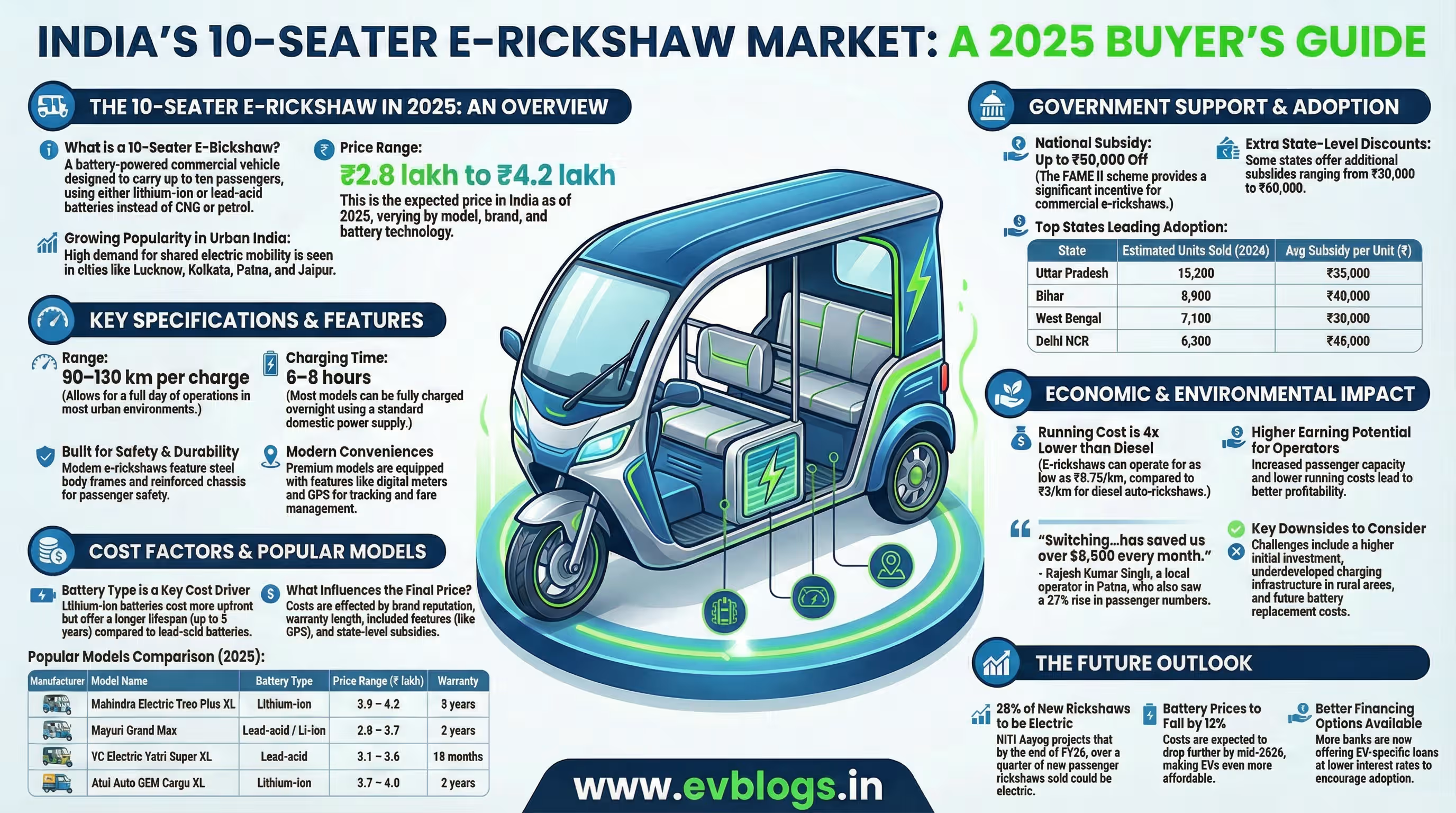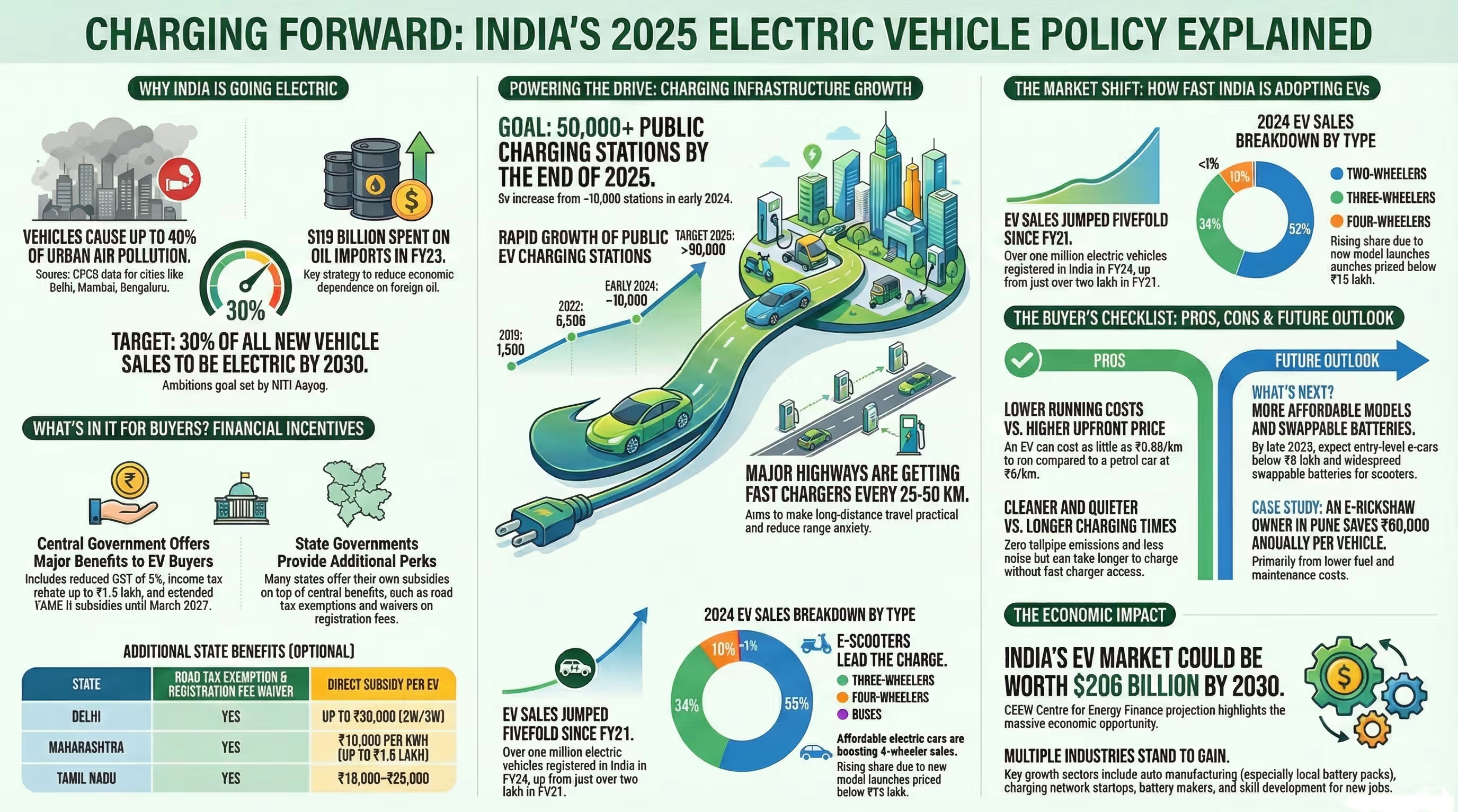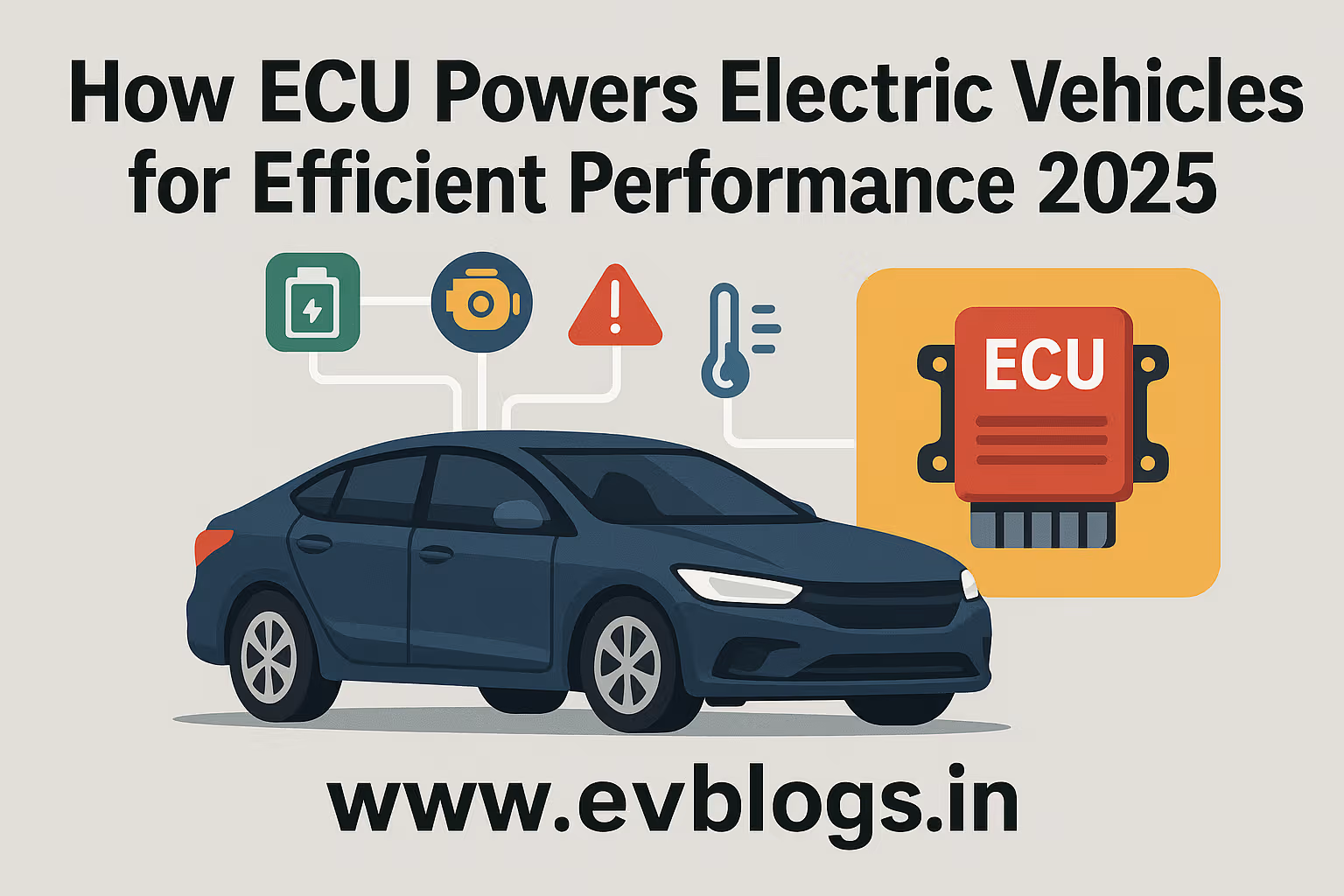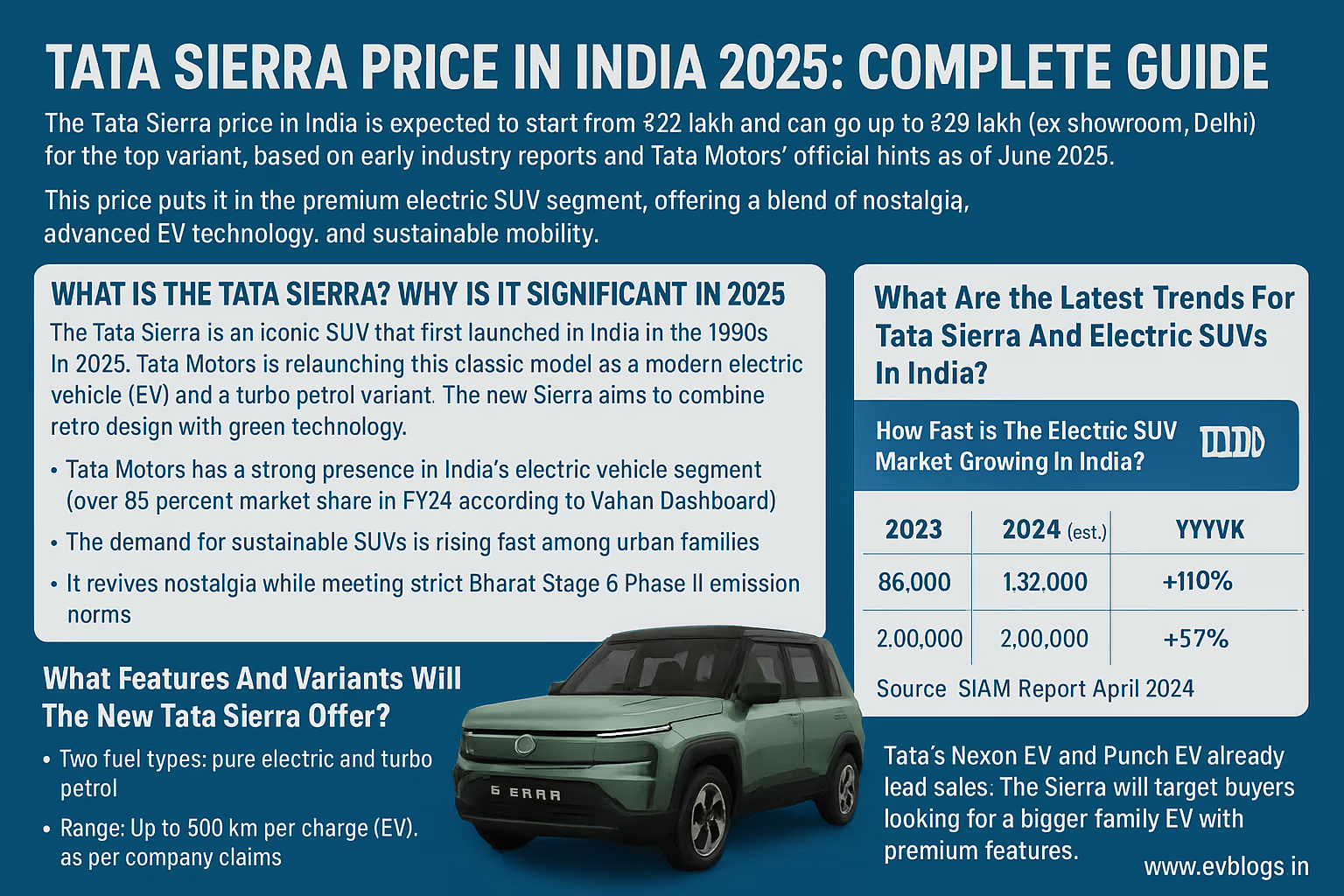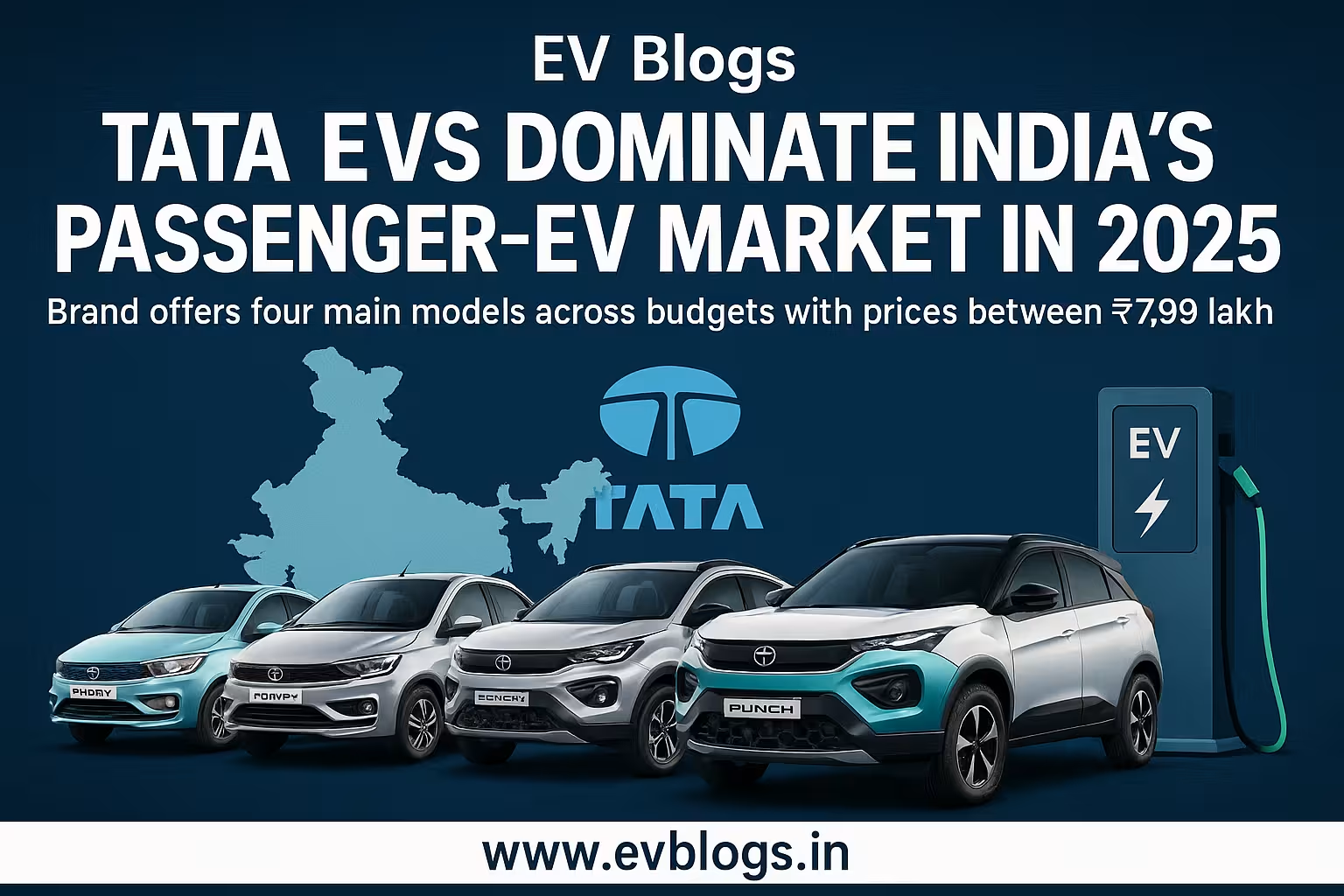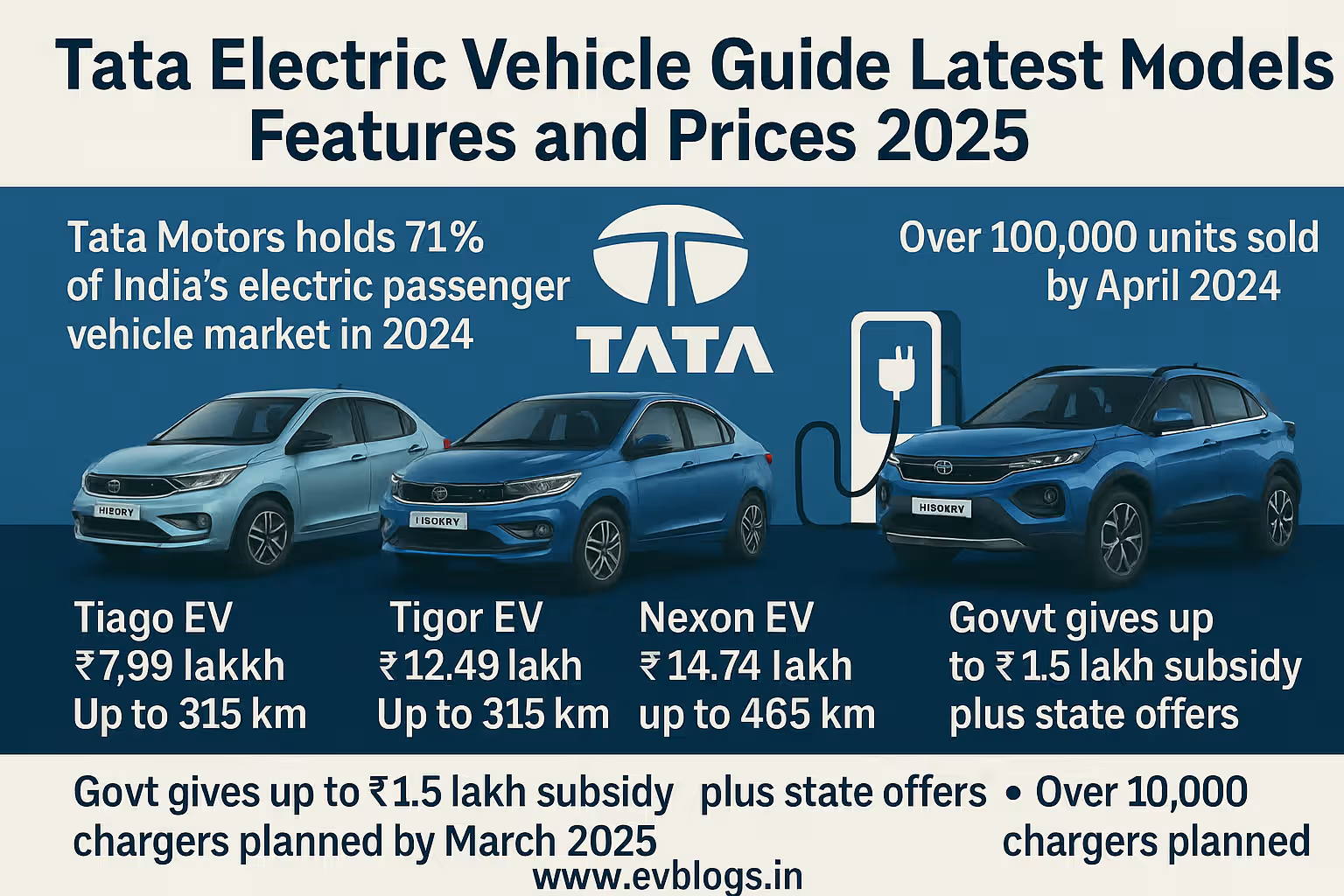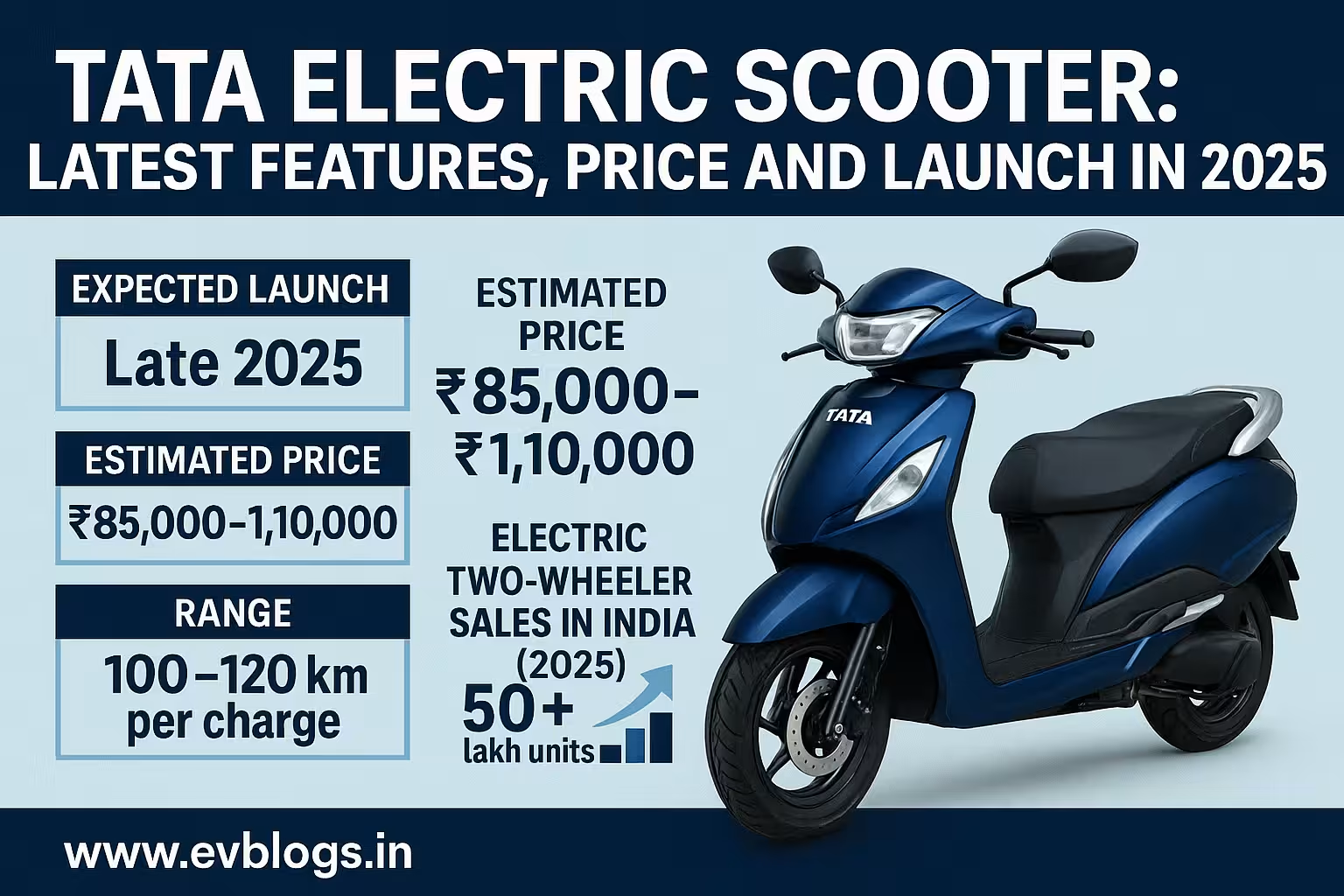Hedhvick Hirav
Hedhvick Hirav is a dedicated EV researcher and editor with over 4 years of experience in India’s growing electric vehicle ecosystem. Their contributions have been recognized in leading sustainability publications and automotive journals.
Summarize & analyze this article with
Choose an AI assistant and open this article directly:
Tip: if the AI doesn’t fetch the page automatically, paste the article URL manually.
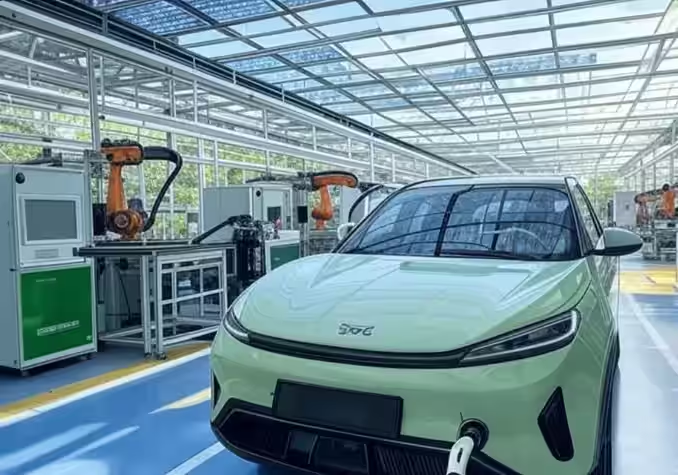
What are the Latest EV Technologies in India in 2025?
India’s electric vehicle (EV) market is booming in 2025, offering you more choices, improved technology, and strong government support. Whether you’re thinking of switching from petrol or diesel to an EV, or just want to stay updated, it’s important to know what’s happening right now.
Over 17 lakh EVs were sold in India in 2024, showing rapid growth. The government’s FAME II (Faster Adoption and Manufacturing of Electric Vehicles) scheme continues into 2025, making EVs more affordable with subsidies. Alongside this, new battery technologies, better charging solutions, and smart vehicle features are now common in Indian EVs.
Important Features of 2025 EV Technologies in India:
- Advanced lithium-ion and LFP (Lithium Iron Phosphate) batteries for longer range and safety.
- Fast-charging networks expanding across cities and highways.
- IoT-connected cars with real-time battery and vehicle health updates.
- Local manufacturing, reducing vehicle costs and import dependence.
- Swappable battery tech in two- and three-wheelers.
- Support for solar charging and green energy integration.
Did You Know?
In 2025, India is home to the world’s second-largest network of EV charging stations in Asia, only behind China.
Why Should You Consider Electric Vehicles in India Today?
You might wonder: Why should you invest in an EV in 2025? The answer goes beyond just saving on fuel.
Key Reasons for Switching to EVs in India:
- Lower Running Costs: Charging an EV costs about ₹1-₹2 per km, much less than petrol or diesel.
- Government Benefits: GST on EVs is only 5%, and you get road tax exemption in many states.
- Environmental Impact: Zero tailpipe emissions help improve air quality, especially in cities like Delhi, Mumbai, and Bangalore.
- Technology Access: Most EVs now have smart features, regenerative braking, and connected apps.
- Resale Value: With rising demand, EV resale values are improving.
Real User Story
Ajay from Pune bought a Tata Nexon EV in 2023. In his words:
“I save nearly ₹5,000 every month on fuel. The app tells me when to charge, and I get free charging at my office. I love the silent drive and quick acceleration!”
Expert Insight
According to NITI Aayog, EVs are expected to capture 30% of India’s private car market by 2030, but adoption is happening much faster than expected due to affordable models and better charging infrastructure in 2025.
Which EV Models Are Popular in India in 2025?
You have more options than ever in 2025, from compact hatchbacks to SUVs, and from budget-friendly scooters to high-end electric bikes.
Top 10 Electric Vehicles in India (2025 Comparison)
| Brand & Model | Type | Ex-Showroom Price (₹ Lakh) | Range (Real-world, km) | Fast Charging (0-80%) | Battery Warranty | Notable Features |
|---|---|---|---|---|---|---|
| Tata Nexon EV | SUV | 14.5 – 17.5 | 325 – 350 | 56 min | 8 years/1.6L km | Smart app, 5-star safety |
| Mahindra XUV400 Pro | SUV | 15 – 18.5 | 375 – 400 | 50 min | 8 years/1.6L km | Fastest Indian eSUV, ADAS |
| MG ZS EV | SUV | 18.9 – 23 | 410 – 440 | 50 min | 8 years/unlimited | Panoramic sunroof, iSmart |
| Hyundai Kona EV | SUV | 23 – 24.5 | 380 – 400 | 57 min | 8 years/1.6L km | Wireless charging, BlueLink |
| BYD Atto 3 | SUV | 28.5 – 33 | 420 – 450 | 50 min | 8 years/1.5L km | LFP battery, large boot |
| Tata Tiago EV | Hatchback | 8.7 – 11 | 210 – 250 | 58 min | 8 years/1.6L km | Compact, affordable, regen |
| Citroen eC3 | Hatchback | 11.6 – 12.8 | 280 – 320 | 57 min | 7 years/1.4L km | French styling, connected car |
| Ola S1 Pro 2nd Gen | Scooter | 1.35 – 1.45 | 180 – 195 | 40 min | 7 years/1L km | MoveOS, hill hold, reverse |
| Ather 450X Gen 4 | Scooter | 1.4 – 1.6 | 140 – 155 | 35 min | 5 years/60,000 km | Touch screen, fast charge |
| Bajaj Chetak Premium | Scooter | 1.35 – 1.5 | 120 – 135 | 50 min | 3 years/50,000 km | Classic style, durable build |
Detailed Descriptions of Popular EVs
Tata Nexon EV:
India’s top-selling electric SUV. Offers best-in-class safety, a practical range for city and short trips, and a connected car app.Mahindra XUV400 Pro:
Known for its acceleration and cabin space. Comes with advanced driver assistance systems (ADAS).MG ZS EV:
Premium SUV feel, loaded with safety features, and great for long drives thanks to high range.Hyundai Kona EV:
Smooth drive, feature-packed interior, and accessible charging network.BYD Atto 3:
Chinese giant’s strong entry in India. Focuses on safety, range, and quirky design.Tata Tiago EV:
Best budget option for families and daily commutes. Easy to park, runs cheap, and great after-sales support.Citroen eC3:
Stylish and fun-to-drive hatch with a European touch. Appeals to young urban buyers.Ola S1 Pro 2nd Gen:
India’s most advanced e-scooter. Loaded with features like navigation, music, and hill-hold.Ather 450X Gen 4:
Known for its sporty ride, touchscreen dashboard, and fast charging.Bajaj Chetak Premium:
Classic legacy, modern heart. Rugged, reliable, and perfect for city travel.
Did You Know?
Over 60% of all electric two-wheelers sold in India in 2024–2025 were made by Ola, TVS, and Ather combined.
How Does EV Charging Work in India in 2025?
EV charging is simpler and faster in 2025 than it was even two years ago. Major cities and highways now have public and private charging options.
Charging Options Available to You:
Home Charging:
- Standard 15A plug can fully charge most EVs overnight (6-10 hours).
- Many apartments and societies now provide dedicated EV charging points.
Fast Charging Stations:
- Located at malls, offices, petrol pumps, and highways.
- DC fast chargers can charge up to 80% in 40–60 mins for most cars.
Battery Swapping:
- Widely used for electric 2- and 3-wheelers (especially in delivery fleets).
- Ola, Bounce Infinity, and Sun Mobility are leading providers.
Mobile Charging Vans:
- Some cities have vans that come to your location for emergencies.
Charging Networks in India:
- Tata Power EV Charging: 5,000+ stations in 250+ cities.
- Ather Grid: 1,800+ fast chargers for two-wheelers.
- Statiq, ChargeGrid, and Fortum: Partnered with malls, tech parks, and fuel stations.
- Indian Oil and BPCL: Rolling out charging at petrol pumps.
Charging Costs:
- Home Charging: ₹7–₹10 per unit (kWh), about ₹150–₹250 for a full charge for most cars.
- Fast Charging: ₹15–₹25 per unit, higher for convenience and speed.
Expert Insight
By 2025, there are over 14,000 public charging stations throughout India, aiming for one station every 3 km in urban areas.
What is the Difference Between EV Battery Technologies in India?
The battery is the heart of your EV. Battery technology determines range, safety, and cost.
Battery Types in Indian EVs (2025):
Lithium-Ion (NMC):
- Most common in cars and high-end scooters.
- Good energy density and performance.
LFP (Lithium Iron Phosphate):
- Growing in popularity for its long life and safety.
- Used by BYD, Tata, some two-wheelers.
Nickel-Metal Hydride (NiMH):
- Rare now, but some hybrid cars use it.
Lead-Acid:
- Mostly phased out, but still seen in a few entry-level two-wheelers.
Comparison of Battery Types (2025)
| Battery Type | Typical Range (km) | Lifespan (Cycles) | Fast Charging Support | Safety | Cost (per kWh) | Common Usage |
|---|---|---|---|---|---|---|
| NMC Lithium | 300–450 | 1,000–1,500 | Yes | Good | ₹15,000–18,000 | Cars, Premium scooters |
| LFP Lithium | 250–400 | 2,000+ | Yes | Very High | ₹13,000–15,000 | New EV cars, Swapping |
| NiMH | 150–250 | 800–1,200 | Limited | Moderate | ₹12,000–14,000 | Hybrids (rare) |
| Lead-Acid | 50–100 | 300–400 | No | Low | ₹8,000–10,000 | Old scooters, e-rickshaws |
Key Takeaways:
- LFP batteries are safer and last longer.
- NMC batteries offer higher range but may cost more.
- Always check battery warranty (minimum 5 years or 1 lakh km is standard in 2025).
- Beware of cheap models with outdated battery tech.
Did You Know?
Tata Motors now sources over 60% of EV batteries domestically, reducing costs and making replacements faster and cheaper for you.
Which Indian States Offer the Best EV Subsidies and Incentives in 2025?
State policies can make a big difference in what you pay for your EV. Several Indian states offer extra incentives in 2025, on top of central government support.
Top EV-Friendly Indian States (2025):
Delhi:
- Waives road tax and registration for EVs.
- Additional subsidy of up to ₹1.5 lakh for cars.
Maharashtra:
- Offers up to ₹1 lakh subsidy on cars, plus incentives for scrapping old vehicles.
- Free charging at government stations for the first year.
Gujarat:
- Subsidy up to ₹20,000 for two-wheelers and ₹1.5 lakh for cars.
- No registration or road tax fees.
Tamil Nadu:
- 100% road tax exemption, subsidy for first 2,000 EV taxis.
Karnataka:
- Pioneered EV policy, offers capital subsidies to manufacturers.
- No road tax for new EVs.
Telangana:
- 100% road tax and registration fee exemption for the first 200,000 EVs.
Uttar Pradesh & Rajasthan:
- Road tax exemption for a limited period.
Kerala, Punjab, Andhra Pradesh:
- Offer various local incentives and infrastructure support.
How to Claim Subsidies:
- Buy an approved model (check the FAME II eligible list).
- Submit required documents at dealership or RTO.
- Subsidy is often credited directly to your bank.
Did You Know?
Delhi had the highest per capita EV sales in India in 2024 and continues to top the charts in 2025.
When Will EVs Become Cheaper Than Petrol Cars in India?
This is one of the most common questions Indian buyers ask. The good news? The price gap is narrowing fast in 2025.
Key Factors Reducing EV Prices:
- Local battery and component manufacturing.
- Lower GST (5% vs. 28% for petrol/diesel).
- Falling battery costs (down by nearly 15% YoY).
- Strong resale and financing options.
- More affordable models (like Tata Tiago EV starting at ₹8.7 lakh).
Price Comparison: EV vs. Petrol (2025)
| Model | EV Price (₹ Lakh) | Petrol Price (₹ Lakh) | Annual Running Cost (₹) | 5-Year Ownership Cost (₹) |
|---|---|---|---|---|
| Tata Tiago | 8.7 – 11 | 6.5 – 8.5 | 16,000 (EV) / 50,000 (Petrol) | 96,000 (EV) / 2.5L (Petrol) |
| Tata Nexon | 14.5 – 17.5 | 10 – 14.5 | 18,000 / 60,000 | 1L / 3L |
| MG ZS | 19 – 23 | 13 – 18 | 20,000 / 65,000 | 1.1L / 3.2L |
Analysis:
- EVs cost more upfront but save you at least ₹30,000–₹40,000 per year in running costs.
- Break-even in 3–5 years for most models, faster in metro cities.
Disclaimer:
- Prices may vary based on location, variant, and subsidy eligibility.
- Running costs are calculated at an average of 12,000 km/year.
Expert Insight
According to CRISIL, by 2026, the upfront price difference between an EV and a comparable petrol/diesel car could drop below ₹50,000 in most Indian states.
How Reliable and Safe Are EVs on Indian Roads?
EV reliability and safety have improved dramatically in 2025. Major Indian and global manufacturers meet strict safety standards.
Safety Features Now Standard in Indian EVs:
- 5-star Global NCAP crash ratings (e.g., Tata Nexon EV).
- Battery thermal management systems to prevent overheating.
- Multiple airbags and ABS/EBD.
- Real-time monitoring of battery health.
- Water and dust resistance (IP67-rated battery packs).
Reliability Factors You Should Consider:
- Most EVs offer 8-year/1.6 lakh km battery warranties.
- Service intervals are longer (fewer moving parts).
- Fewer breakdowns reported compared to ICE vehicles.
- OTA (over-the-air) software updates fix bugs and add new features.
First-Hand User Experience
Pooja from Bangalore, who owns an MG ZS EV, says:
“I drive 60 km daily. My MG ZS EV has never let me down, even in monsoons. The app alerts me if my charge is low or if a tire needs air. My husband’s 2-year-old petrol car has needed more repairs than my EV!”
Did You Know?
In 2025, Indian EVs are required to pass new AIS-156 battery safety regulations, making them safer than ever before.
What are the Running and Maintenance Costs of EVs in India?
One of the biggest advantages of owning an EV in India in 2025 is the low cost of ownership.
EV Running Costs (2025):
- Average cost per kilometre: ₹1–₹2 (vs. ₹6–₹8 for petrol, ₹5–₹7 for diesel).
- Maintenance is about 25–40% lower due to fewer moving parts.
Typical Annual Costs (for a mid-size sedan/SUV):
- Electricity: ₹12,000–₹20,000 (for 12,000 km/year).
- Maintenance: ₹2,000–₹5,000 (mainly tire rotation, brakes, air filters).
- No oil changes or emission checks needed.
Maintenance Checklist for Indian EV Owners:
- Check battery health with the app or at service center.
- Keep tires inflated correctly (EVs are heavier).
- Software updates (done automatically for most).
- Clean and check brake pads (less wear due to regenerative braking).
Expert Insight
According to Tata Motors, over 90% of EV service issues can be resolved at home or via mobile service vans in 2025.
Which Charging Apps and Networks Should You Use in India?
In 2025, using the right app makes charging your EV much easier. Most networks offer real-time updates, locating stations, and even booking slots.
Best EV Charging Apps for Indian Users (2025):
- Tata Power EZ Charge – Largest car charging network, easy payment.
- Ather Grid – Best for two-wheelers, wide urban coverage.
- Statiq – Pan-India, supports both cars and two-wheelers.
- ChargeGrid (Magenta) – Good for corporate parks and highways.
- BPCL eDrive – Expanding at major fuel stations.
- EV Plugs – Aggregates all networks for easy comparison.
- PlugShare – Community-driven station locator with real-time reviews.
How to Use These Apps:
- Download from Google Play or App Store (free).
- Register your vehicle and payment method.
- Find nearest charger, check availability, and book ahead if needed.
- Pay via UPI, card, or wallet.
- Get notified when charging is complete.
Pro Tips:
- Always check connector compatibility (CCS2, Type 2, CHAdeMO, or Bharat DC001).
- Carry your own charging cable for emergencies.
- Keep an eye on downtime alerts in the app.
Did You Know?
In 2025, EV charging is included as part of new apartment amenities in most metro cities like Mumbai, Delhi, Bangalore, and Chennai.
How Does the Indian Government Support EV Adoption in 2025?
The government is one of the biggest drivers for EV adoption in India. Multiple schemes and policies are in place to make EV ownership easier and cheaper.
Key Government Initiatives (2025):
FAME II Scheme:
- Up to ₹35,000 subsidy for two-wheelers, ₹1.5 lakh for four-wheelers.
- Extended till at least March 2026.
Reduced GST:
- Only 5% GST on EVs and chargers.
Income Tax Benefits:
- Up to ₹1.5 lakh deduction on interest of loans taken for EV purchase (Section 80EEB).
PLI (Production Linked Incentive) Scheme:
- Encourages local battery and component manufacturing.
Charging Station Mandates:
- Every new building in major cities must have EV charging infrastructure.
Green License Plates:
- Easier identification, parking, and lane access in some states.
Scrappage Policy:
- Extra incentive if you scrap an old petrol/diesel car and buy an EV.
How This Helps You:
- Lower purchase price.
- Reduced cost of charging and maintenance.
- Easier to get loans and insurance for EVs.
Did You Know?
As of 2025, over ₹10,000 crore has been allocated by the Indian government for EV adoption and charging infrastructure.
What Challenges Remain for EV Technologies in India?
While 2025 is a great year for EVs in India, some challenges still exist. It’s good to know these before you buy.
Ongoing Challenges (2025):
- Public Charging Coverage:
- Still sparse in rural and tier-2 cities.
- Range Anxiety:
- Improving, but long highway drives require careful planning.
- Upfront Cost:
- Still higher than base petrol models without subsidy.
- Battery Recycling:
- Infrastructure being developed, but not yet widespread.
- Service Network:
- Not all small towns have specialized EV workshops.
- Second-Hand Market:
- Still developing, but improving with rising demand.
What You Can Do:
- Check charging station coverage in your area.
- Consider your daily driving range vs EV range.
- Factor in service support, especially if living outside major metros.
Expert Insight
Over 80% of EV buyers in metros report high satisfaction, but in smaller cities, awareness and charging infrastructure are still catching up in 2025.
How Can You Decide if an Electric Vehicle is Right for You in 2025?
Making the switch to an EV is a big decision. Here are some checkpoints to help you decide:
- Estimate your daily commute and match it with real-world EV ranges.
- Check if your city/state offers good subsidies and charging infrastructure.
- Calculate your total cost of ownership (including fuel savings).
- Look for models with longer battery warranty and good resale value.
- Test drive multiple models to feel the difference.
- Talk to current EV owners in your city or on online forums.
Final Verdict
If you live in an urban or semi-urban area, drive less than 200 km daily, and want to save on running costs, buying an EV in 2025 is a smart, future-ready choice. With better technology, strong government support, and increasing charging infrastructure, EVs are now practical for most Indian families and businesses.
Conclusion
Indian EV technologies in 2025 are more advanced, accessible, and affordable than ever. With new models, local manufacturing, government subsidies, and a rapidly expanding charging network, there’s never been a better time to go electric.
You’ll enjoy low running costs, modern features, and the satisfaction of contributing to a cleaner environment. While some challenges remain, the market is ready for mainstream adoption.
Ready to explore?
Visit your nearest dealership, test drive an EV, or join an EV community group to learn more. Your switch could spark the change India needs.
FAQ – EV Technologies in India (2025)
Q1. Are EVs really suitable for long drives in India?
Yes, with many models offering 300+ km range and growing fast-charging stations along highways, long trips are possible. Plan routes and charging stops for hassle-free travel.
Q2. What is the typical battery replacement cost for Indian EVs?
In 2025, battery replacement costs have fallen to ₹3–₹5 lakh for cars, and ₹40,000–₹70,000 for scooters. Most batteries last 8–10 years, often outlasting ownership.
Q3. How long does it take to charge an EV at home?
Home charging via a 15A socket usually takes 6–10 hours for a full charge. Fast chargers outside can do 80% in under an hour for most vehicles.
Q4. Can EVs handle Indian road and weather conditions?
Modern EVs are tested for Indian roads, weather, and monsoons. IP67-rated batteries and reinforced chassis ensure safety and performance.
Q5. Is it easy to get finance and insurance for EVs in India?
Yes, banks and NBFCs offer special low-interest loans for EVs, and all major insurers have special EV insurance products with roadside assistance.
Disclaimer: All prices, policies, and statistics are accurate as of June 2025. Please check with your local dealer or government authority for latest updates before making a purchase.


